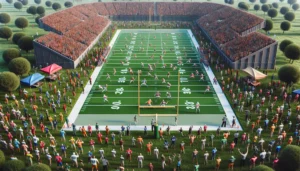Ever wondered just how big NFL players are? It’s one thing to see them on the screen, but understanding the actual sizes of these athletes provides a whole new perspective. From towering offensive linemen to compact, yet powerful running backs, the NFL is a showcase of physical diversity.
Let’s delve into the world of professional football and explore the size and physique of these athletes. You’ll discover the role size plays in different positions, and how the physical attributes of these players contribute to their performance on the field. Buckle up for an exciting journey into the world of NFL player sizes.
Offensive Linemen Size
Zooming in on one position, offensive linemen represent the largest players on the field. This size is an undeniable asset in the game of football. But how big are we talking about?
The average height of NFL offensive linemen is around 6’5″. That’s about the height of your average door frame. Think about it, these ginormous individuals stand taller than most people’s reach. Quite an intriguing fact isn’t it?
Meanwhile, the average weight swings closer to 312 pounds. We are talking about the weight of a full-size refrigerator here, and mind you, not just any small dorm room fridge.
Figure 1: Average size of offensive linemen in NFL
| Height | Weight | |
| Average | 6’5″ | 312lb |
Being an offensive lineman isn’t just about being big, it’s about using that size effectively. They use their size and strength to block defenders, creating paths for running backs and protecting the quarterback. A greater weight provides these players the additional anchoring force, making it harder for opponents to push them around.
Moreover, two key strategies offensive linemen apply include “drive blocking” and “pass blocking.” In drive blocking, linemen leverage their massive size to move defenders off the ball, while in pass blocking, they exploit their bulk to establish a protective pocket for the quarterback.
It’s not just about height and weight; arm length also plays a crucial role. An offensive lineman with longer arms can keep pass rushers at bay, keeping them too far away to tackle the quarterback effectively. Longer reach typically means better performance in this role, emphasizing upper body length as a prime physical factor.
Such impressive sizes of these athletes reflect an integral aspect of this vigorous sport, illustrating how size and physique allow the offensive linemen to dictate the play. With every step these giants take, you’re witnessing the raw power of towering figures mastering one of the most thrilling sports on the planet.
👉 To explore how player attributes influence the game, check out “Winning with Wisdom: Understanding Common NFL Point Spreads“.
Running Backs Physique
While offensive linemen are the giants of the NFL, let’s not overlook the running backs. You might be asking yourself, how big is a typical NFL running back? Although these players aren’t as massive as their offensive lineman teammates, they pack a punch and play a crucial role on the field.
NFL running backs are usually between 5’10” to 6’2″ tall – height here isn’t as big of a factor as with offensive linemen. However, their weight can typically range from 215 to 230 pounds. Despite the difference in stature, these players are renowned for their agility, speed, and strength.
| Statistic | Average Value |
| Height | 5’10” – 6’2″ |
| Weight | 215 – 230 lbs |
Arm length usually measures from 30 to 32 inches – similar to offensive linemen, this attribute allows running backs to fend off defenders and maintain ball control during crucial stages of the game. Their powerful lower bodies also assist them in making explosive plays.
Unlike the offensive linemen who use their size for blocking, running backs use their physique for a different set of skills. They rely on their speed and strength to swiftly move the football down the field, either by outrunning the defenders or by powerfully pushing through them. Their physical attributes, coupled with their strategic techniques, make them invaluable assets to the team.
An interesting facet of running backs is their durability. Unlike many positions in football, they’re often on the receiving end of hard impacts, making their physical resilience key to enduring these brutal encounters. Building a robust physique is therefore integral to their role, aiding in both performance and longevity.
To sum up, while NFL running backs may not be as tall as their offensive linemen counterparts, they own a unique set of physical attributes vital for their role on the field. They are the powerhouses, capable of swift explosive movements and accustomed to enduring intense physical battles. Height might not play a significant part in their case, but their strength and agility undeniably do.
Diversity in Player Sizes
In the NFL, there’s no one-size-fits-all. It’d be a gross oversimplification to label it as a league filled only with towering, superhuman specimens. The truth is that there is considerable diversity in player sizes, with a substantial variation in physical attributes even within the same position.
Take the quarterback position as an instance. The stature of quarterbacks ranges from Drew Brees, who stands at 6’0″, to the outlier, Brock Osweiler, a towering figure at 6’7″. Physical characteristics of quarterbacks significantly impact their style of play, defining their unique signature on the field.
Let’s observe this trend across multiple positions:
| Position | Height Range | Weight Range |
| Offensive Linemen | 6’3″-6’8″ | 305-355 lbs |
| Quarterbacks | 6’0″-6’7″ | 215-245 lbs |
| Wide Receivers | 5’10”-6’3″ | 185-225 lbs |
| Tight Ends | 6’3″-6’7″ | 235-260 lbs |
Speed, strength, and agility are never mutually exclusive. A player’s size can affect speed, while their build might influence their strength. The right mix of physical attributes defines their success in the particular role they play. That’s why you’d observe how a 5’10” wide receiver is equally valuable on the field as a 6’6″ offensive lineman.
Moreover, it’s important to note that players’ sizes vary according to the specific roles they play within their positions as well. For example, among wide receivers, slot receivers often stand shorter and leaner than their outside counterparts, aiming for agility over physical dominance.
This variation is not just a mere feature of the sport; it’s its beauty. As one might marvel at the sheer force commanded by a hulking lineman, one can also appreciate the swift, cheetah-like agility of a shorter, lighter running back or receiver. In this way, the NFL celebrates not just raw power, but a symphony of diverse body types performing their piece in perfect harmony.
Diversity in NFL player sizes is quite intriguing. It’s not just about towering figures bulldozing their way but also agile gazelles darting through gaps. Watching the players and understanding their roles and physical attributes just adds to the fascinating drama that is NFL football.
Role of Size in Different Positions
In the labyrinth of the NFL, size matters in a unique way. It’s not always the tallest or heaviest players that dominate the field. Each position requires a specific set of physical attributes for optimum performance and success.
Get a load of this: Quarterbacks generally range between 6’2″ and 6’6″ in height. With their towering stance, they are better equipped to see over offensive and defensive lines. Heaviness isn’t a prime requirement for them, but enough strength to withstand hits is crucial.
Offensive Linemen on the other hand are the “goliaths” on the field. Their bodies need to be massive with commanding height and weight (commonly 6’5″ and 315 pounds respectively). With the primary job of defending the quarterback, their size becomes a human barricade against the opponent’s defensive line.
Now meet the Wide Receivers. While height can be an advantage for catching passes, it’s not a strict requirement. Players in this position typically range between 5’10” and 6’3″ in height and weigh 185-225 pounds. However, what’s more crucial for them? Speed and agility. Their build needs to support sudden accelerations and sharp turns to evade the defenders.
And finally, the Tight Ends. They are a blend of offensive linemen and wide receivers – that is, if you’re looking at them from a size perspective. Their ideal height is around 6’3″ to 6’6″, and they typically weigh between 240 and 270 pounds. This hybrid sizing makes them effective as both pass catchers and blockers.
It’s vital to understand here that size isn’t everything in NFL. Fitness levels, agility, speed, and strategy also play significant roles. In the next section, we’ll dive deeper into how players maintain their specific sizes and what role diet and exercise play in their routines. Stay tuned.
Impact of Player Physique on Performance
Diving deeper into the realm of NFL, you’ll quickly understand that each position has a unique set of physical demands that consequently influence performance. Remember, the size, build, and physical attributes of a player significantly correlate with their performance on the field. However, it’s a mix of these physical attributes, in conjunction with abilities like speed, agility, fitness, and strategy, that further fine-tunes a player’s capability.
Quarterbacks, the spearheads often towering above their teammates, require height for better visibility across the field. This enhanced line of sight provides an edge in passing accuracy and decision making, crucial components of an effective quarterback. And it isn’t just about being tall, sturdy built quarterbacks are better fitted to withstand the rigors of the sport, allowing them to sustain longer in the game.
Note: In contrast to the prevalent belief that bigger is better, relatively smaller, agile wide receivers and running backs often fare better. Their swift maneuverability and explosive acceleration compensate for a lack in physical stature and truly exemplify “size doesn’t matter”.
Shifting focus to the mammoths of the game, the offensive linemen, you’ll find that their impressive size and strength aren’t just for intimidation. Their role demands them to be the first line of defense, standing against the onslaught of the opposing team. Consequently, having a larger frame can aid their blocking abilities, providing quarterbacks and ball carriers more time to execute plays.
Tight ends, on the other hand, showcase a hybrid of skills and size. They are required to alternate between functions of an offensive lineman and a wide receiver, needing the right balance of speed, strength, size, and hands.
Key Point Fitness horsepower is just as important regardless of your position. The fitter the player, the better their potential output and the lower risk of injury.
Exploring the significance of player sizes in different positions can unquestionably affirm the credence, it’s not the size that counts, it’s what you do with it. Next, let’s dive into how the players maintain these physiques through tailored diets and exercises, designed to match their needs on the field.
The Road to Becoming an NFL Giant
One must bear in mind that, although it may seem as though size is everything in American football, dedication to training and refining technique still reigns supreme when determining success on the gridiron. Many of today’s top NFL performers have dedicated their lives to honing their skills and sculpting their physiques to meet the demanding needs of the sport.
- Nutrition: Players need to consume vast quantities of food to fuel their incredible workouts and maintain their hefty mass. Many adhere to diets high in carbohydrates and protein to achieve this while managing proportions and frequency of intake for a tailored approach.
- Strength & Conditioning: Given the taxing nature of American football, strength and conditioning programs form an essential element of preparation for all aspiring pros. Plans involve rigorous sessions designed to build muscle power, endurance, speed, and agility that are paramount in achieving triumph on the field.
- Precision Drills: Apart from the broader athletic skill set molded by intensive workouts, players need to consistently perfect position-specific activities. This meticulous focus on the nuances of their roles involves countless hours of repetition and practice, fostering a deep expertise that is foundational for success.
Conclusion
You’ve now seen how the size of NFL players varies by position and impacts their performance. Quarterbacks benefit from height, while agility gives wide receivers and running backs an edge. Offensive linemen’s larger build aids in blocking and tight ends need a combination of skills and size. But remember, size isn’t everything in the NFL. It’s also about how players use their physical attributes. Fitness is vital across all positions for peak performance and injury prevention. And let’s not forget the importance of tailored diets and exercises in maintaining these impressive physiques. So, while size does matter in the NFL, it’s not the sole factor of success. It’s how you use what you’ve got that truly counts.
1. Does player physique impact NFL performance?
Yes, according to the article, player physique significantly impacts performance in the NFL. Different positions require varied physical attributes, such as height, build, and strength, all affecting player effectiveness.
2. How does height benefit quarterbacks?
Height benefits quarterbacks by providing better visibility over the offensive line, and durability, as taller players tend to withstand hits better, contributing to a longer playing career.
3. Why are agility and smaller size beneficial for wide receivers and running backs?
Smaller, agile players, like wide receivers and running backs, can excel in maneuverability. This attribute allows them to weave through opposing defense efficiently, often leading to successful offensive plays.
4. How does an offensive lineman’s size aid their performance?
An offensive lineman’s size helps them to effectively block opposing defensive players, providing a clear path for the team’s offensive plays.
5. What physical attributes are important for tight ends?
Tight ends require an optimal blend of size and skill. Their role often demands a mix of blocking and receiving, necessitating strength, agility, and good hand-eye coordination.
6. Can fitness impact player performance and injury prevention?
Fitness plays an essential role in player performance and injury prevention across all NFL positions, as stated in the article. Proper fitness aids in enhancing performance while contributing to injury prevention.
7. Is a player’s success in the NFL solely determined by size?
No, while size is a crucial factor, a player’s success in the NFL is not solely determined by it. How players utilize their physical attributes in their respective roles is equally important.
8. How do NFL players maintain their physique?
NFL players maintain their physique through tailored diets and exercises, suited to their respective positions. This regimented approach plays a significant role in optimizing and preserving their physical attributes.



